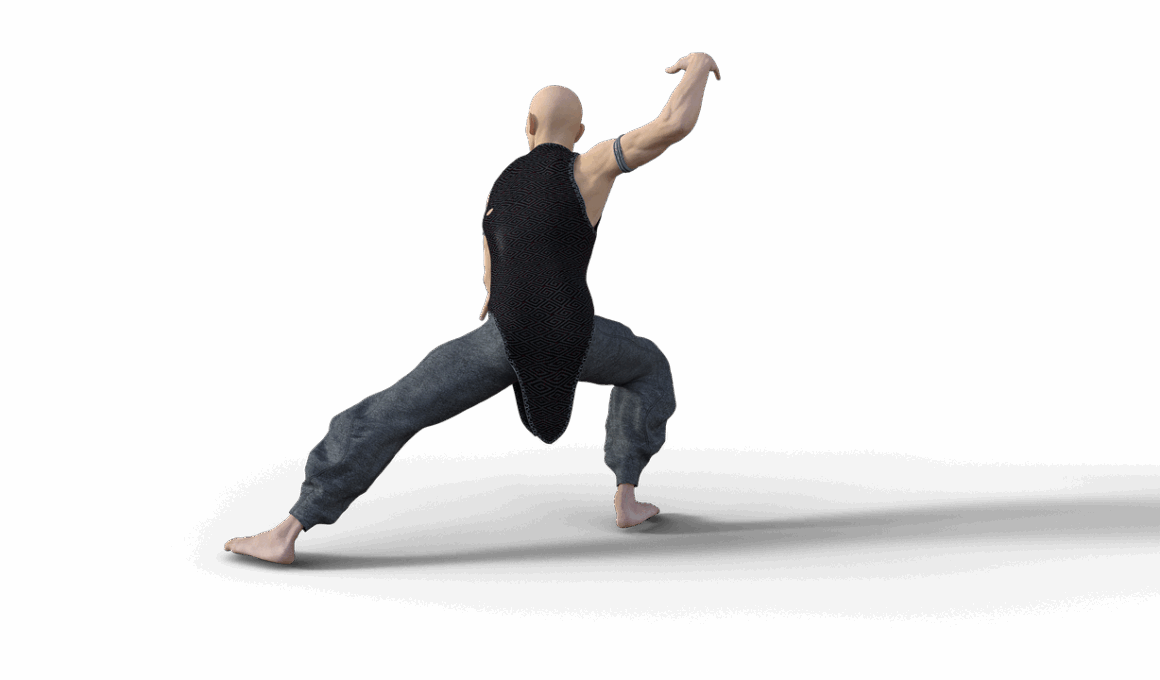Breathwork Methods Every Martial Artist Should Know
Breathing techniques play a crucial role in martial arts, enhancing performance, focus, and relaxation. Mastering your breathing can improve your endurance and control during intense training sessions. One essential technique is abdominal or diaphragmatic breathing. This method involves deep breathing through your abdomen rather than your chest. To practice, inhale deeply through your nose, allowing your abdomen to expand, and exhale slowly through your mouth. This technique not only facilitates better oxygen delivery to your muscles but also helps maintain calmness under pressure. Additionally, incorporating rhythmic breathing, which synchronizes breath with movement during training, can enhance overall rhythm and coordination. Practicing this with punches and kicks can significantly increase your flow. Furthermore, martial artists may find box breathing beneficial, promoting relaxation and focus during competition. You can practice this method by inhaling for four counts, holding for four counts, exhaling for four counts, and then holding again for four counts. Keeping track of this breathing pattern will deepen your focus and maintain energy levels. Embracing such diverse techniques enhances your performance and contributes to a comprehensive understanding of your body.
Benefits of Controlled Breathing
Controlled breathing is an invaluable tool for martial artists, providing both mental and physical advantages. By incorporating breath control techniques, you are better able to manage stress during combat situations. Maintaining control of your breath helps decrease adrenaline levels, allowing for a more strategic approach to your movements. Improved lung capacity from regular practice leads to enhanced endurance, thus enabling you to train harder and recover faster. Controlled breathing techniques also assist in maximizing energy efficiency. This means you can execute techniques without exhausting yourself too quickly, maintaining stamina throughout your sparring rounds. Additionally, focused breathing techniques provide valuable aid during meditation and visualization practices, essential components of martial arts training. Engaging in mindful breathing aids in maintaining mental clarity and presence, allowing for quick decision-making during an intense match. Overall, mastering controlled breathing can lead to heightened awareness, agility, and greater resilience against distractions. Apart from physical gains, these techniques boost self-discipline and mental strength, both integral to martial arts. Every martial artist should prioritize learning and practicing controlled breathing methods, ensuring a well-rounded approach to their training.
Breathing rate not only affects your physical performance but can also impact your focus and agility. The technique of inhaling during explosive actions like strikes helps prepare your body for the then explosive output. It establishes a rhythm that allows a martial artist to maintain optimal energy levels, leading to smoother transitions between techniques. Controlled inhalation is equally crucial during defense or evasive maneuvers. For instance, inhaling during movement enables heightened awareness of surroundings, while exhaling during execution helps maintain core stability. Another method to explore is pursed lip breathing, which extends the exhalation phase, further promoting relaxation and energy conservation. It’s simple: inhale through your nose and exhale slowly through pursed lips, much like blowing through a straw. This technique delays your breath intake, allowing for better carbon dioxide discharge, enhancing your oxygen efficiency. Integrating variations of breath patterns while practicing can help find those that work best in specific techniques. Therefore, avoid limiting yourself to just one or two methods. Experimenting with multiple techniques allows for greater adaptability during training and competition settings, unlocking your fullest potential throughout your martial arts journey.
Integrating Breathing Techniques into Training
Integrating breathing techniques into your martial arts training routine is essential for continued growth and effectiveness. Start by introducing breathing exercises during your warm-up sessions. This practice sets a foundation for deeper breathing techniques and encourages better overall awareness in your body during training. Engaging in breath control exercises before and after sparring drills leads to improved focus and recovery. Next, dedicate specific practice times focusing solely on incorporated breathing methods, ensuring you are applying them during active techniques. During these sessions, concentrate on coupling breath with movements, such as empowering kicks or thrusting punches. Try Steve’s Three-Step Breath Method: inhale deeply, execute the movement, and exhale sharply upon impact or release. Regularly revisiting these techniques during your training can yield significant results over time. Cultivating breathing awareness and control becomes second nature, reinforcing muscle memory. Further, recording your breathing patterns during practice rounds allows for progress tracking and a greater understanding of strengths and weaknesses regarding breath control. Experiment with documenting actions and related breath patterns, paving the way toward personalized training adjustments. Ultimately, this will promote sustained energy and focus throughout any martial arts practice.
Breathing techniques can also enhance your recovery process following intense training or competition. Focused breathing exercises can help clear lactic acid build-up in your muscles, reducing soreness and fatigue. Engaging in deep belly breathing post-workout facilitates your body’s natural healing response while promoting relaxation. Take a few minutes each session to practice restorative breathing techniques. For instance, combine gentle stretches with deep diaphragmatic breaths, allowing your body to relax and release tension accumulated during training. Additionally, visualize positive outcomes through breathwork to strengthen your mental focus, essential for upcoming competitions. Craft a mental space where you can unwind while practicing your chosen breathing technique. Furthermore, utilizing breathing exercises aids in creating routines that include meditation or visualizations, thereby promoting self-awareness and emotional balance. In doing so, you lay the groundwork for developing resilience in competitive situations, as these exercises can help cultivate mental clarity under pressure. Additionally, consider seeking the guidance of a qualified instructor to refine your breathwork skills. Continuous practice under expert guidance enables constructive feedback and accelerates mastery, thus enhancing your martial arts journey and sense of well-being.
Breath Control for Endurance
Longer training sessions necessitate optimal breath control for enhanced endurance; otherwise, fatigue sets in. Breathing techniques train your cardiovascular system to function more efficiently, essentially providing more energy for your martial arts practice. High-intensity interval training seamlessly integrates with breath control methods. Adapting breath patterns in tandem with intervals enables practitioners to push beyond common physical limits. Utilize the 5-2-7 technique during these sessions: inhale for five counts, hold for two counts, and exhale for seven counts. This coordination promotes efficiency in oxygen use, boosting your stamina. Additionally, employing visualizations during breath-focused work boosts mental engagement, creating a comprehensive training session. Focus on envisioning yourself successfully executing techniques while controlling your breathing patterns; doing so establishes a strong connection with your body. Alongside sprints or drills, utilize breath control during cooldowns, ensuring proper oxygen replenishment. Notably, building breath control simultaneously improves stamina and assists in quicker recovery—a win-win! Thus, engaging in intentional breathwork optimally suits endurance-specific training. As a martial artist, committing to breath regulation augments your long-term performance, enabling you to maximize your efforts effectively.
The Importance of Consistency
Consistency is the key to mastering any skill, including breathwork for martial artists. Integrating breath control exercises into your daily regimen fosters gradual improvement and lasting change. Set aside specific times each week to focus on your breathing practice. Whether it’s during your warm-ups or after a training session, remain diligent and committed. Many martial artists fall short in their pursuit of improvement when they overlook this fundamental aspect. To remain consistent, consider creating a structured schedule that incorporates various breathing techniques, allowing for a more comprehensive understanding. Furthermore, re-evaluate your progress over time through self-assessments or journal entries focused on breathwork. Seeking out workshops or classes dedicated to breath control and mindfulness techniques can also elevate your practice further. Additionally, connecting with fellow martial artists and sharing experiences regarding breath techniques can foster motivation within your community. Since mastering breath control aids performance, every martial artist, regardless of skill level, should embrace its benefits and embed it within their daily training. By prioritizing consistency in breathwork, you establish enhanced performance levels and broader understanding within your martial arts journey.



